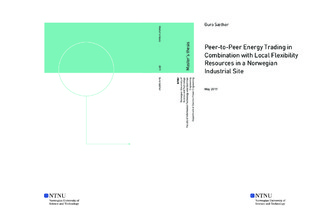| dc.description.abstract | Med den økende utrullingen av desentraliserte fornybare energikilder og energikrevende enheter møter dagens kraftsystem nye utfordringer. Som et behov for fleksible alternativer på lokalt nivå. Det betyr at kraftsystemets konvensjonelle struktur kan endres, når kunder går primært fra å være pris takere til å være aktive kunder med produksjon. En slik restrukturering krever nye ideer for markedsdesign som hensyn tar lokale aktører. Fremtredende løsninger for å redusere belastningen på overføringsnettet og fremme distribusjon av fornybare energikilder, er energilager og peer-to-peer (nabo) energihandel på lokalt nivå. En annen lovende løsning kan være å innføre et effektledd i nettleien for gi sluttbrukere et insentiv til å redusere effekttopper. Industri- og næringskunder er allerede tariffert med et kostbart effektledd, og faktureres for den høyeste effekttoppen hver måned.
Etter som flere design for lokale marked har blitt foreslått for bolignabolag og smarte nett, presenterer denne hovedoppgaven to markedsdesign for et industriområde med fokus på rollen til peer-to-peer energihandel. Industribygg har et høyt energi- og effektbehov, og dermed en betydelig kostnad relatert til strømforbruk. I denne studien vurderes verdien av peer-to-peer energihandel i kombinasjon med lokale fornybare energi- og fleksibilitetskilder for et industriområde lokalisert i Midt-Norge. Målet er å minimere de totale strømkostnadene for industriområdet, samtidig som det sikres et rettferdig lokalt marked. En optimaliseringsmodell, basert på multi-steg lineær programmering, er utviklet og simulert over ett år i GAMS. Flere case-studier har blitt utført med last- og produksjonsdata levert av den lokale netteieren, NTE Nett AS.
Resultatene viser at peer-to-peer energihandel gir økonomiske fordeler til industriområdet, samt hvert enkelt industribygg, med årlige totale strømkostnadsbesparelser på 6.8 \% og 11.0 \% for de to markedsdesignene. Peer-to-peer energihandel er også svært gunstig for å redusere effekttopper, med totale besparelser i effekttoppkostnader på 15.0 \% og 25.5 \%. Med effektleddet i nettleien som driver, bidrar dette til de største kostnadsreduksjonene for industriområdet. Videre brukes mer av den fornybare produksjonen lokalt, hvor på ingen produksjon er tapt og mindre er solgt til distribusjonsnettet. | |
| dc.description.abstract | With the increasing deployment of decentralized renewable energy sources (DERs) and energy demanding devices, the power system is facing new challenges, such as the need of flexibility options at local level. Meaning that the power system conventional top-down structure might change as consumers are becoming more active entities. Such a restructuring requires new ideas for market designs that considers local energy features. Thus, energy storage systems and peer-to-peer (P2P) energy trading have emerged as new ways to decrease the stress of the grid and foster the deployment of DERs. Another promising solution to incentive consumers to reduce their power demand and forward efficient network utilization, is to implement a peak power charge in the grid utility tariff. Industrial customers are already subject to such a peak power charge, and are billed for the highest peak drawn from the grid each month.
As some local market designs have been proposed for residential communities and smart grids, this study proposes two market designs for an industrial site centered on the role of P2P energy trading. With higher energy demand and a peak power charge, industrial consumers are subject to a considerably cost of electricity. In this study, the value of P2P energy trading in combination with various local generation and flexibility resources are assessed for a Norwegian industrial site. The objective is to minimize the total cost of electricity, while ensuring a fair market design for all participants in the industrial site. In this regard, the system operation of P2P trading subject to the peak power charge is an additional contribution to the existing literature. An optimization model, based on multi-period linear programming, is built and simulated with a time horizon of one year in GAMS. Several analyses are carried out using time series (representing a proxy industrial site) provided by the grid owner, NTE Nett AS, located in central Norway.
The main findings note that P2P energy trading is able to bring economic benefits to the industrial site, as well as to the individual buildings, with yearly net savings of the total cost of electricity of 6.8 \% and 11.0 \% in the two local markets. Further, using P2P energy trading for peak shaving purposes are highly beneficial. The total cost of peak power is reduced 15.0 \% and 25.6 \% in the two case studies, with the substantial peak power charge as key driver, making peak shaving the largest contributor to the net cost savings. Moreover, the industrial site consumes more distributed generation locally, with no power curtailment and reduced grid feed-in. The thesis provides novel results on the benefits of P2P energy trading, especially with regards to industrial customers and the peak power charge. | |
